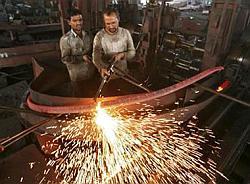 | « Back to article | Print this article |
If one look at the growth of sectors individually, industries such as metals, mining, machinery, and transportation have seen a decline. They show close contemporaneous correlations with the business cycle. Ordinarily, a growth rate of 2.4 per cent in industrial production shouldn't be cause for relief, let alone celebration.
Ordinarily, a growth rate of 2.4 per cent in industrial production shouldn't be cause for relief, let alone celebration.
It speaks volumes for the state of the economy when such a low number is greeted with some cheer, having exceeded many analysts' expectations.
And the January 2013 year-on-year number is somewhat better than the abysmal 1 er cent growth registered during the April-January period, compared to an already sluggish 3.4 per cent during the corresponding period of the previous year.
The reversal in direction, however slight, does support the assertion by the finance ministry and other government spokespersons that the economy has bottomed out, the worst is behind us, and we can look forward to somewhat faster growth in the coming year.
However, this confidence appears misplaced once the disaggregated numbers are scrutinised. Mining showed a decline of 2.9 per cent in January, reinforcing its negative trend over the past year.
The bans on mining activity in some parts of the country are presumably contributing to this and there is no reversal in sight.
While the manufacturing sector, which accounts for almost 80 per cent of the index, grew by 2.7 per cent, the performance of individual segments within it varied widely.
Tobacco products and garments grew by almost 20 per cent each, while miscellaneous electrical machinery grew by a striking 47 per cent.
However, even this was not enough to boost the capital goods sector into positive growth; it declined by 1.8 per cent in January, and by close to 10 per cent during the April-January